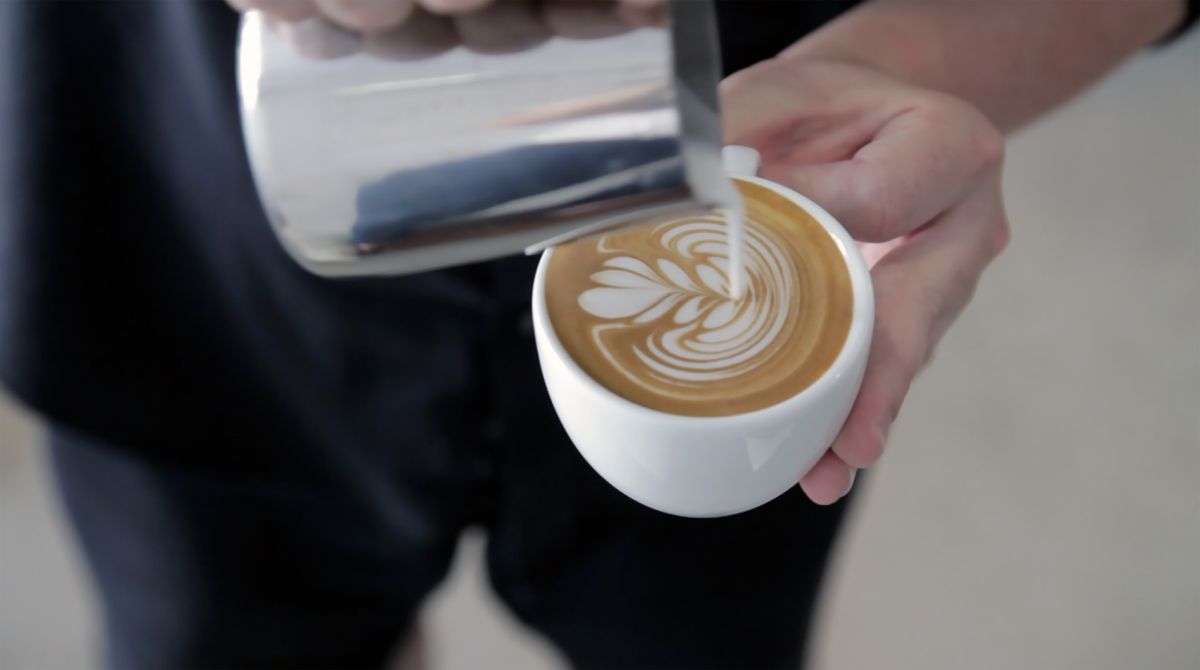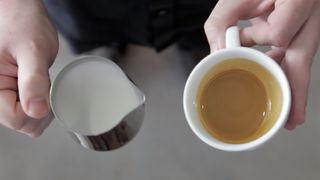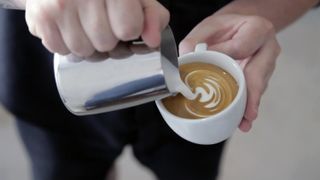
How Does Latte Art Work?

Latte art has become a hallmark of many quality coffee shops around the world. If you order a drink made with espresso and steamed milk, such as a cappuccino or a latte, you may find yourself marveling over the elegant, marbled patterns of earthen browns and shimmering white that top your beverage. But how do baristas create such works of art?
The designs take shape when a barista pours the drink into a cup; steamed milk over a couple shots of espresso. The impressive creations are a blend of the skill of the barista and the physical properties of the mixture of air and liquid: a foam.
"Foams are very complex and interesting fluids," Emilie Dressaire, an engineer who leads the Particles, Interface and Fluids Lab at New York University, told Live Science in an email. This makes it difficult to know exactly what's going with latte art without studying it specifically. [10 Things You Need to Know About Coffee]
One thing is for certain: Milk doesn't turn into foam by itself.
"Simply put, we steam the milk for two reasons," Lorenzo Perkins, owner of Fleet Coffee in Austin, Texas, and a former chairman of the Barista Guild of America, told Live Science.
Properly steamed milk tastes sweeter, and the texture is thick and luxurious. "Making it sweet and creamy is really the goal," Perkins said.

There are two main steps to steaming a pitcher of milk, said Jesse Gordon, an instructor with Counter Culture Coffee in North Carolina. First, the milk is aerated with the hiss of a steam wand, and then swirled in a "whirlpool" to break up large bubbles into "microfoam." When done the right way, "you get that really nice velvety, wet paint texture," Gordon told Live Science.
Sign up for the Live Science daily newsletter now
Get the world’s most fascinating discoveries delivered straight to your inbox.
The steamed milk's hydrophobic molecules (the ones that don't interact with water), such as the proteins and fats in milk, create a latte foam, said Matthew Hartings, who teaches a course about the chemistry of cooking at American University in Washington, D.C. "Proteins have both hydrophobic and hydrophilic [water-loving] parts, so proteins are really good at stabilizing foams," he said.
Manufacturers can make milk alternatives, like almond milk, shelf stable by adding emulsifiers such as xanthan gum, which helps keep fats suspended in the water. "Things that help to stabilize oil and water mixtures also tend to be good at stabilizing water-based foams," Hartings said. So, additives originally intended to keep some products from separating also improve the texture of a coconut milk latte.
Whether it starts with milk or an alternative, the finished foamy product will be a "porous viscoelastic material," said Howard Stone, head of the Complex Fluids Group at Princeton University in New Jersey. [Liquid Beauty: Dreamy Images Reveal Fascinating Physics]
Because it's porous, the milk foam will hold other fluids, like steam-injected air, but also espresso in between the bubbles. "The coffee is like the ink," Stone said. "[Liquid areas] are letting you print black and white."
Viscoelasticity means the foam will bounce back to its original shape when deformed slightly, but will also flow like a liquid if enough force is applied, Dressaire said. And the nature of that flow could be key to the marbling effect that the best latte art is able to achieve.
Rather than combining turbulently with milk already in the cup, newly added milk mixes in sheets, a motion called laminar flow. The stark borders that form between colors in the cup hold up, at least for a little while, because of the foam's elasticity.
"The slow, honey-like flow of the foam — that's the reason why the white and brown foams have a hard time mixing, and makes this pattern last," Dressaire said.

Baristas can control the churning by adjusting the way they pour the milk. "Pace, position and proximity," Perkins said. "How fast is the milk moving into the coffee? Where is the milk entering the coffee? And how close is the steaming pitcher to the coffee?"
Perkins designed a course called "Milk essentials and latte art practices" for the Specialty Coffee Association of America. "Varying those three things is what's going to allow you to create various shades of white and brown; various sizes and shapes of the design; and how you can draw on top of it," he said.
All three of the main types of latte designs begin with pouring steamed milk into one spot in the middle of a cup, Gordon said. From there, the barista can draw a trail of milk through the dot to create a heart; stop and start again to create something that looks like a tulip; or gently rock the pour back and forth, before pulling the milk through waggling lines to make a fern-like pattern.
The drinks can be beautiful, but coffee experts caution against drinking with your eyes. "Latte art doesn't taste like anything," Gordon said. "If you have good latte art, it means you've properly textured your milk, which is one part of the equation. Hopefully, you couple that with coffee that is dialed-in and tasting great."
Original article on Live Science.
Most Popular

